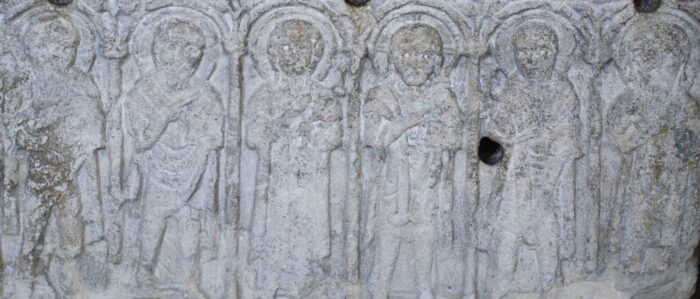The Puzzle of the Hedda Stone.
The evening of May 11th the last monthly meeting before the three annual Summer visits was a particularly wet evening but, despite the weather, the meeting was well attended. We welcomed some guests from the Cathedral congregation to the meeting.
The evening’s speakers were Dr Jackie Hall, the Peterborough Cathedral archaeologist and Teresa Porciani who is in her final year of her PhD at the University of Leicester, studying Figural Sculpture dating between s 700-800AD. The topic for the evening was The Hedda Stone.
The Hedda Stone is unique. The best preserved and largest Anglo-Saxon sculpture in the Country. Today it can be found in the Apse Chapel of Peterborough Cathedral. The stone was thought to have been carved somewhere between the late 9th and early 10th century. It’s a house-shaped, solid block of Barnack stone, a known Reliquary shape, carved on all sides. The front and back depict twelve saints with halos, six on each side. The pointed roof and the ends have symbols and beasts carved into it. Researching the stone, Teresa Porciani has managed to identify some of the Saints, but the more she researches the more questions the stone throws up.
Dr Jackie Hall spoke of the known history of the stone, The legend of the stone first appeared in a late 14th-century chronicle written by the Abbot of Croyland (or Crowland). It was thought to be carved to commemorate the destruction of the Abbey at Medehamstede (later known as Peterborough)and the slaughter of eighty-four monks and the Abbot Hedda of Medehamstede by the Danes in around 870 AD.
Dr Hall continued to relate the known history of the stoned and its position and condition over the following centuries. It was first located on the South side of the Cathedral grounds but subjected to the weather and the attention of the vandal in the subsequence years it was decided In 1714 that the stone would be moved into the Library of the Cathedral and later in 2018 to its present position in the Apse Chapel, behind the High Alter of the Cathedral.
The Peterborough History Society would like to thank Dr Hall and Ms Porciani for their illustrated and informative talk about what is known through in-depth research of this unique Anglo-Saxon stone.
11/05/2023
Please Note: This meeting has finished.

